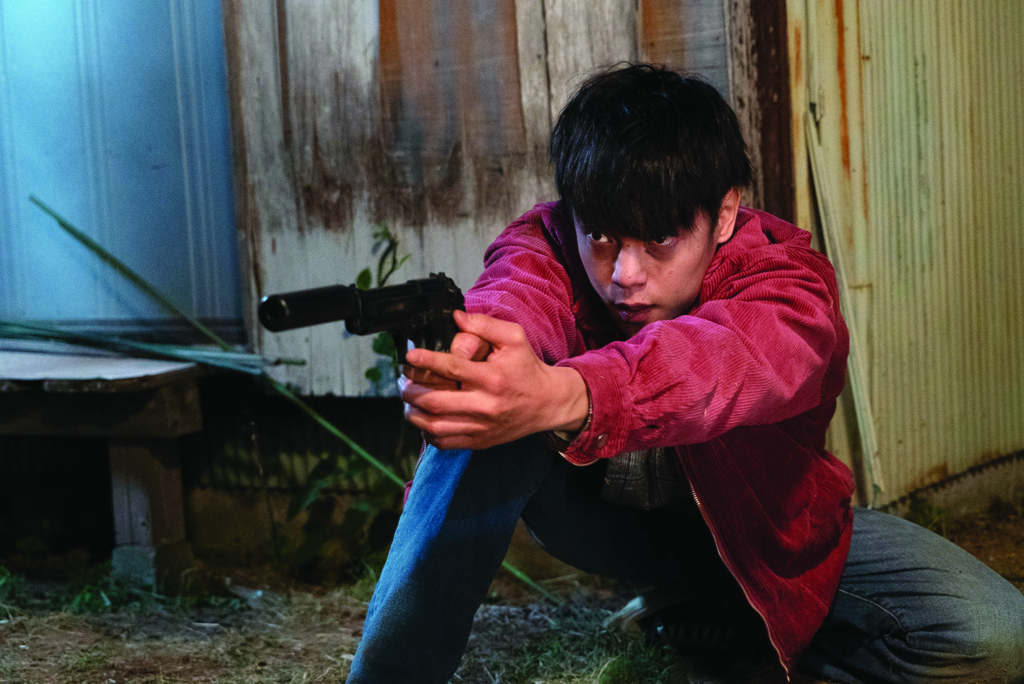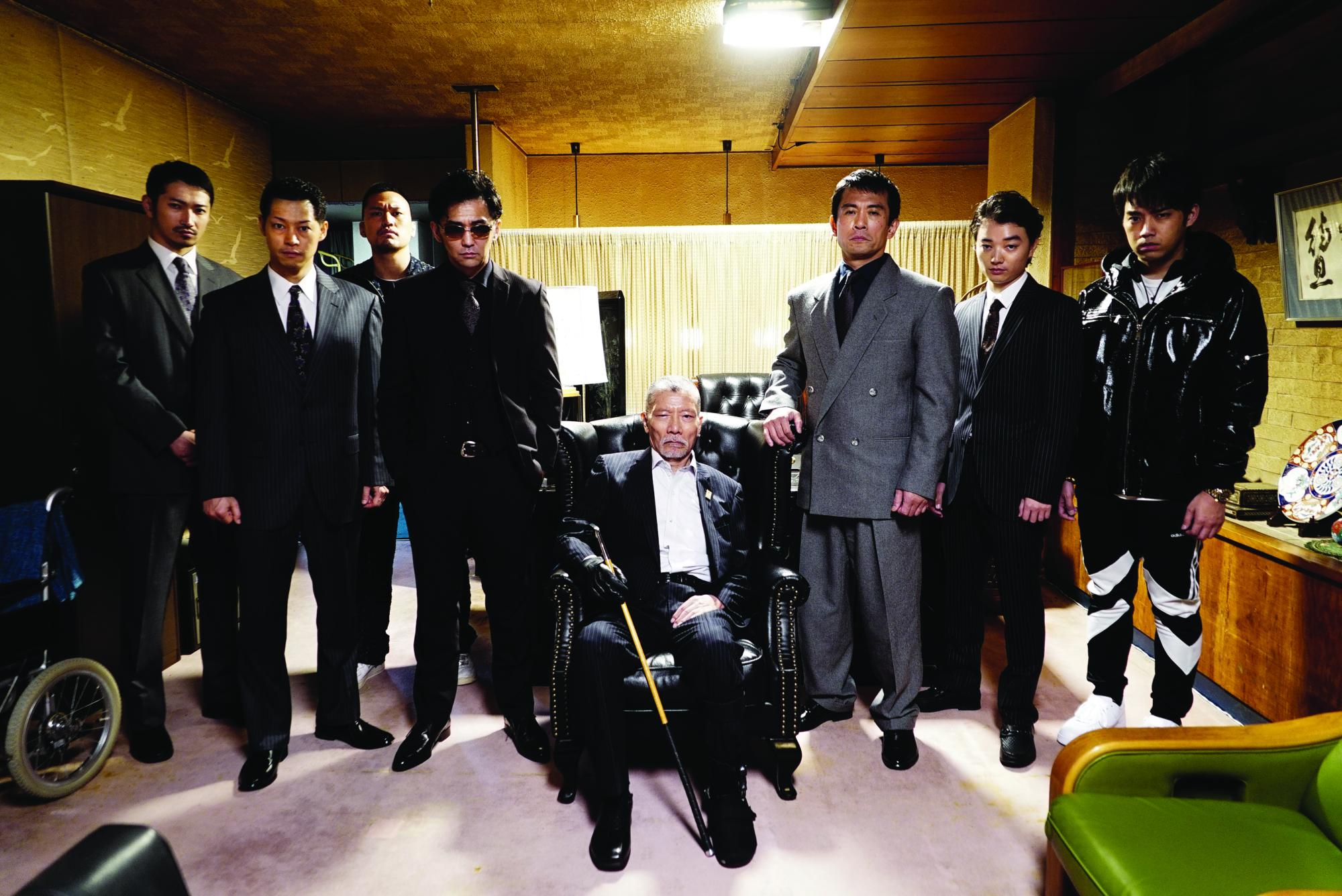Takashi Miike’s output at once attracts and resists film criticism. There’s an undeniable allure to his work, a combination of unbridled insanity, restless creativity and – among it all – a distinctive worldview that offers his oeuvre something approximating auteurism. But any tendency to collapse his filmography into something coherent is reflexively resisted by the sheer size of said filmography, which stretches into the triple digits.
That makes it easy for a film like First Love (2019) to sail under the radar. Miike’s 103rd film doesn’t cover any new ground, necessarily. A yakuza thriller with a hefty sprinkling of black comedy, the film doesn’t drastically deviate in its subject matter from defining texts like Dead or Alive (1999) or Ichi the Killer (2001). Those two films featured shocking moments that catapulted Miike to international infamy as a representative of the so-called ‘Asia Extreme’[1]Associated with the label established by distributor Tartan Films in the early 2000s; see Chi-Yun Shin, ‘Art of Branding: Tartan “Asia Extreme” Films’, Jump Cut, no. 50, 2008, pp. 85–100, available at <https://www.ejumpcut.org/archive/jc50.2008/TartanDist/>, accessed 11 May 2020. movement; First Love, while hardly family-friendly, lacks anything as attention-grabbing. The film doesn’t fit neatly into the critical conversation surrounding Miike. Without truly transgressive content, it doesn’t fit the narrative of ‘cinema of outrage’[2]Tony Williams, ‘Takashi Miike’s Cinema of Outrage’, CineAction, no. 64, 2004, pp. 54–62. that critics in the early 2000s used either to boil Miike’s work down to its most extreme elements, or alternatively to characterise it as symbolising the ‘rapidly changing world facing the Japanese population […] in which the worst aspects of globalization and postmodernism have called former values into question’.[3]ibid. Nor does the film initially invite the kind of deep, scholarly analysis you tend to find in publications such as this one.

That leaves First Love in the sort of critical no man’s land that much of Miike’s work has occupied over the better part of the past couple of decades. I side with film historian Aaron Gerow’s 2009 assertion that critical analysis of Miike falls foul of the genre/arthouse binary. As he puts it,
The problem with these approaches is that […] they seek a precise location for a director who […] seems nomadic in terms of style and politics, and less concerned with collapsing the divisions between surface and depth or the image and reality than engaging in the more complex possibility of wandering between these poles.[4]Aaron Gerow, ‘The Homelessness of Style and the Problems of Studying Miike Takashi’, Canadian Journal of Film Studies, vol. 18, no. 1, Spring 2009, pp. 25–6.
First Love is not an ‘elevated genre’ film, the kind of nonsense label dreamt up by critics loath to take B movies seriously. This is a genre film to its very bones. Yes, it’s postmodern, in the sense that it is deeply aware of the filmic archetypes its characters embody; but, rather than reframing or reinterpreting these archetypes, it’s content to merely represent them. The comparatively muted cultural impact of First Love can be credited to these factors, but there are others at play, whether it’s the sheer density of Miike’s ever-growing filmography or a modern distribution network that prioritises international films with arthouse bona fides – see: Parasite (Bong Joon-ho, 2019)[5]Don’t take this as Bong shade; Parasite is an excellent film that deserved its accolades. But it’s interesting to note that the narrative around its importance tended to focus on its thematic depth at the expense of its craft and pure entertainment value. Nowadays, ‘international’ films have to be framed as ‘artistic’ to warrant mainstream attention. – over their genre counterparts.
But I’d argue that First Love is more than deserving of critical attention. In large part, that’s due to the formal prowess on display. This is an astonishingly effective piece of entertainment, something that would appeal to audiences beyond Miike fan boys and extreme-cinema aficionados … were it given the chance. Such technique is especially significant viewed in the context of an evolution of Miike’s prowess; rather than a feint at respectability,[6]Critic James Robert Douglas argues that Miike’s invitation to Cannes in 2017 for his hundredth film, Blade of the Immortal, cemented his ‘path to international respectability’. See Douglas, ‘Cutting Through the Chanbara Film: Takashi Miike’s Blade of the Immortal’, Metro, no. 196, 2018, pp. 58–63. First Love represents a refinement of the gonzo craft he’s known for.
Smash decapitation
The development of Miike’s abilities over his career is evident from First Love’s opening frames. Where his earlier yakuza films – including the aforementioned Dead or Alive and Ichi the Killer – began with frantically cut, urgently scored montages evoking amphetamine-induced delirium, his latest film offers a more conventionally cut scene of protagonist Leo (Masataka Kubota) practising his boxing technique in a shadowy gym, accompanied by pounding didgeridoo-heavy dance music. Lest we’re mistakenly lulled into an assumption that the director’s abandoned his outré inclinations, we smash cut from a punch landing to a severed head tumbling out of an alleyway. A close-up of said head’s shocked eyes frantically blinking confirms that we’re in familiar territory.
In contrast to earlier Miike films, where moments of insanity seem engineered to distract from failings in the storytelling, here the craziness is neatly incorporated into the ongoing narrative.
When Miike attracted international attention at the turn of the millennium, he was entering his forties. But the youthful, unorthodox energy of his prolific output earned him the ‘enfant terrible’ descriptor.[7]See, for example, Chris Chang, ‘Japanese Enfant Terrible Takeshi [sic] Miike Serves Up a Truly Visceral Experience’, Film Comment, vol. 38, no. 3, May/June 2004, p. 18. His quick-and-nasty approach to filmmaking, born of years in the Japanese OV[8]Stands for ‘original videos’, roughly equivalent to direct-to-video B movies and/or ‘video nasties’ in the West. industry, became his trademark. Of course, things weren’t quite that simple. Miike’s films frequently juxtapose quick-cut dynamism with long-shot distancing, a seeming contradiction that many early critics found difficult to reconcile.[9]Gerow argues that ‘critics […] often end up creating an artificial distinction between the postmodern aesthetics supposedly more typical of Miike and the long-take style that is said to drown out or “suppresses” the former, effectively dividing what is “truly” Miike from what is not’. Gerow, op. cit., p. 32.
Miike has always been more than an ‘outrageous’ auteur, but it’s easy to understand why you might focus on the more extreme aspects when characterising his work. An archetypal Miike movie features at least one moment so utterly unexpected that it’s hard for it not to resonate. Consider the excursions into claymation in The Happiness of the Katakuris (2001), the arrival of the ‘modern monster’ (a man in a grubby inflatable frog costume) in Yakuza Apocalypse (2015) or the utterly batshit closing minutes of Dead or Alive, in which an until-then-comparatively-realistic yakuza film uses an inexplicable magic fireball to incinerate the Earth.
But I think centring the discourse on such extremities detracts from the formal qualities and narratives surrounding them. While it’s interesting to investigate how such provocations align with, say, Japanese national identity, I think it’s just as important to examine how they’re deployed. More often than not, Miike’s ‘extreme’ moments seem to operate as a crutch, a way of smoothing over the less effective elements of his films by searing something shocking into his audience’s minds. You might remember Dead or Alive for its propulsive prologue or its absurd ending … and, in the process, forget and forgive the uninspired yakuza-vs-cop narrative that forms the bulk of the film.
First Love is different. While embodying many of the trademark characteristics of a ‘typical’ Miike film, its escalating absurdities are effectively incorporated into a storyline that remains coherent despite a sprawling cast of characters. That aforementioned smash cut to the decapitated head is a great example of this; while cosmetically in tune with provocative moments from the director’s past, it’s clarifying rather than confusing for audiences. This sequence makes the film’s tone clear – expect violence, but don’t expect to take it too seriously – while foreshadowing Leo’s inevitable tangling with the yakuza underworld that produced said decapitation.

Extreme evolution
The conceit for First Love isn’t far removed from Miike’s turn-of-the-century output. A yakuza gang, headed up by Gondo (Seiyō Uchino), is set on a collision course with the Chinese triad led by Gondo’s nemesis, the aptly-named One-Armed Wang[10]Because, as you might have guessed, he’s missing an arm (due, we’re told, to a long-ago showdown with Gondo). (Yen Cheng-kuo), because of a convoluted scheme involving drugs, violence and an extensive cast of characters. But where I’d get lost in the particulars of his earlier works, here each step of the storyline and each sliver of characterisation is sharp and unambiguous.
Take another early scene, introducing Kase (Shōta Sometani) and Otomo (Nao Ohmori[11]Unrecognisable some two decades from playing the titular role in Ichi the Killer.). The pair share a brief conversation at the crime scene set up around the aforementioned severed head, and, within the space of a few lines of dialogue, it’s clear that Kase’s a yakuza member (likely tied up in the events preceding the decapitation), Otomo’s a world-weary cop and – based on their friendly rapport – they’re in cahoots. The exposition is unambiguous without being didactic, incorporated into a formal approach that prioritises clarity over chaos.
By the time the two attempt to scam another yakuza of a meth stash, we’re across everything that’s going on. We’ve met enough of the yakuza and triad members to understand the key players involved when Kase tries to frame the triad for the robbery and ignite a gang war. We’ve met Yasu (Takahiro Miura), the target of the robbery; his girlfriend, Julie (Becky); and their captive sex worker, Monica (Sakurako Konishi), who’s imprisoned by both her drug addiction and her father’s debts. Once the wheels are in motion – and, swiftly, come disastrously off – each subsequent step is both ludicrous and lucid. In contrast to earlier Miike films, where moments of insanity seem engineered to distract from failings in the storytelling, here the craziness is neatly incorporated into the ongoing narrative.

This isn’t necessarily an artistic evolution, I’ll concede. Clearer storytelling doesn’t always coincide with better art. Yet, in this case, it makes First Love a more engaging, entertaining and funny film than many of Miike’s well-regarded yakuza movies. Moments like Kase inexplicably transforming into a near-invincible madman impervious to pain by smearing meth into his bullet wounds barely rates on the scale of absurdity found in Miike’s other films, but because the character and the storyline surrounding him are so clearly defined, it’s funnier than the more extreme moments in the director’s filmography (Sometani’s committed, anarchic performance doesn’t hurt, either).
It’s tempting – and likely accurate – to credit this coherency as a by-product of Miike’s career trajectory over the preceding two decades. In developing his technical skills, Miike has undeniably produced a string of films that stray into anonymity. Critics have argued that, for instance, his ‘opportunities to experiment have dried up and we are left now with a predominantly industrial Miike’,[12]Randolph Jordan, ‘Missed Calls and Shangri-las: Revisiting 15 Years of Takashi Miike Coverage at Fantasia’, Offscreen, vol. 21, no. 3, March 2017, available at <https://offscreen.com/view/revisiting-15-years-of-fantasia-miike-coverage>, accessed 11 May 2020. while others have acknowledged that this industrial era has meant that ‘Miike’s technical experience now seems fully ingrained’.[13]Douglas, op. cit., p. 60.
First Love, though, is neither an example of experimentation nor gun-for-hire work. It’s not just the yakuza-thriller setting. Nor is it the cosmetic similarities to Miike’s back catalogue: the many severed limbs (and heads); the way the spectre of Monica’s underwear-clad father[14]At once terrifying – he represents Monica’s trauma and abuse – and undeniably hilarious, he is hard to surpass as a symbol of First Love’s unique approach to storytelling. recalls the minotaur from Gozu (2003); or how the climactic shift into animation to cover an overly expensive stunt mirrors The Happiness of the Katakuris’ claymation sequences. Rather, unlike many of the films in the intervening years since the publishing of Tom Mes’ 2003 book Agitator: The Cinema of Takashi Miike, First Love embodies the six defining characteristics the author identifies:
• the rootless individual
• the outcast
• the search for happiness
• nostalgia
• the family unit
• violence.[15]Tom Mes, Agitator: The Cinema of Takashi Miike, FAB Press, Godalming, UK, 2003, pp. 21–33.
As a boxer with no enthusiasm for life soon saddled with a terminal brain-tumour diagnosis, Leo exemplifies the rootless individual – lacking purpose or a true home. Monica, whose relationship with Leo is where the film finds its title, is the outcast, and their quest for survival after being targeted by yakuza and triad members alike gradually transforms into an archetypal search for happiness. First Love could, therefore, easily slot alongside the canonical early works that supported Mes’ analysis seventeen years ago.
Significantly, the film suggests the maturation of Miike’s outlook, thanks to an optimistic ending that cuts against the perspective common to his early works. Here, the ‘search for happiness’ manifests itself in Leo and Monica’s relationship – his quest for purpose, her escape from addiction and, ultimately, their love. Mes speaks of the doomed nature of this search for ‘the ideal partner’[16]ibid., p. 27. in Miike’s films, asserting that ‘in all these cases, the actual creation of the couple proves to be an impossible goal’.[17]ibid. While that may have been true of the films that defined Miike’s early career, First Love sees the director – in full auteur mode – adjusting his worldview. The film concludes with Leo triumphantly celebrating a boxing win with a joie de vivre he’s never previously possessed, Monica successfully detoxing from her addiction and the couple moving into a new apartment together, no longer rootless or outcast.
First Love might be, at its core, just a superbly crafted genre film. But, for Miike aficionados, it’s evident that the director’s distinctive talents haven’t abated. If anything, they’ve evolved with growing formal sophistication born of years of industrial work, and softened through a generosity of spirit absent from his attention-grabbing early films.
Endnotes
| 1 | Associated with the label established by distributor Tartan Films in the early 2000s; see Chi-Yun Shin, ‘Art of Branding: Tartan “Asia Extreme” Films’, Jump Cut, no. 50, 2008, pp. 85–100, available at <https://www.ejumpcut.org/archive/jc50.2008/TartanDist/>, accessed 11 May 2020. |
|---|---|
| 2 | Tony Williams, ‘Takashi Miike’s Cinema of Outrage’, CineAction, no. 64, 2004, pp. 54–62. |
| 3 | ibid. |
| 4 | Aaron Gerow, ‘The Homelessness of Style and the Problems of Studying Miike Takashi’, Canadian Journal of Film Studies, vol. 18, no. 1, Spring 2009, pp. 25–6. |
| 5 | Don’t take this as Bong shade; Parasite is an excellent film that deserved its accolades. But it’s interesting to note that the narrative around its importance tended to focus on its thematic depth at the expense of its craft and pure entertainment value. Nowadays, ‘international’ films have to be framed as ‘artistic’ to warrant mainstream attention. |
| 6 | Critic James Robert Douglas argues that Miike’s invitation to Cannes in 2017 for his hundredth film, Blade of the Immortal, cemented his ‘path to international respectability’. See Douglas, ‘Cutting Through the Chanbara Film: Takashi Miike’s Blade of the Immortal’, Metro, no. 196, 2018, pp. 58–63. |
| 7 | See, for example, Chris Chang, ‘Japanese Enfant Terrible Takeshi [sic] Miike Serves Up a Truly Visceral Experience’, Film Comment, vol. 38, no. 3, May/June 2004, p. 18. |
| 8 | Stands for ‘original videos’, roughly equivalent to direct-to-video B movies and/or ‘video nasties’ in the West. |
| 9 | Gerow argues that ‘critics […] often end up creating an artificial distinction between the postmodern aesthetics supposedly more typical of Miike and the long-take style that is said to drown out or “suppresses” the former, effectively dividing what is “truly” Miike from what is not’. Gerow, op. cit., p. 32. |
| 10 | Because, as you might have guessed, he’s missing an arm (due, we’re told, to a long-ago showdown with Gondo). |
| 11 | Unrecognisable some two decades from playing the titular role in Ichi the Killer. |
| 12 | Randolph Jordan, ‘Missed Calls and Shangri-las: Revisiting 15 Years of Takashi Miike Coverage at Fantasia’, Offscreen, vol. 21, no. 3, March 2017, available at <https://offscreen.com/view/revisiting-15-years-of-fantasia-miike-coverage>, accessed 11 May 2020. |
| 13 | Douglas, op. cit., p. 60. |
| 14 | At once terrifying – he represents Monica’s trauma and abuse – and undeniably hilarious, he is hard to surpass as a symbol of First Love’s unique approach to storytelling. |
| 15 | Tom Mes, Agitator: The Cinema of Takashi Miike, FAB Press, Godalming, UK, 2003, pp. 21–33. |
| 16 | ibid., p. 27. |
| 17 | ibid. |





